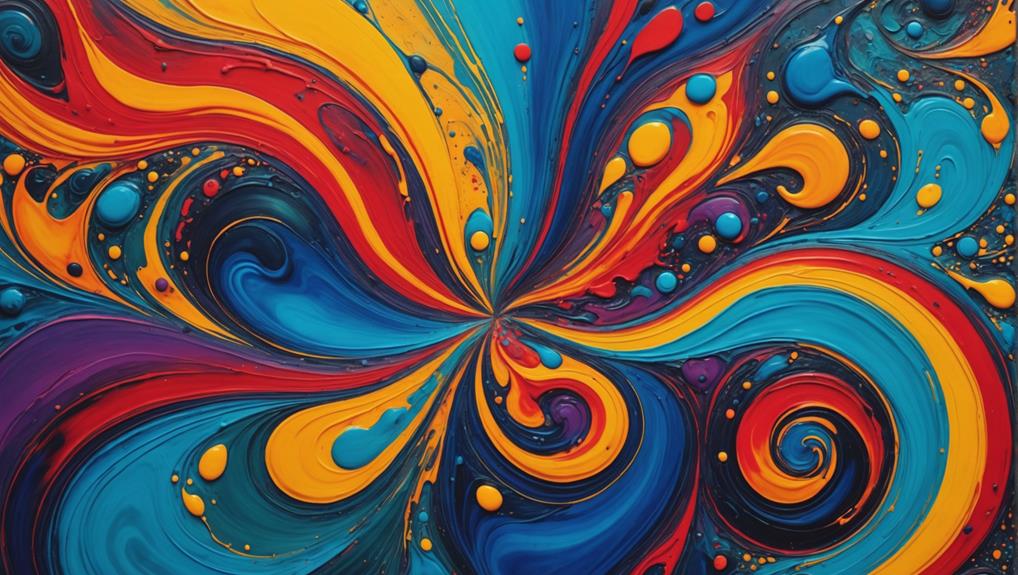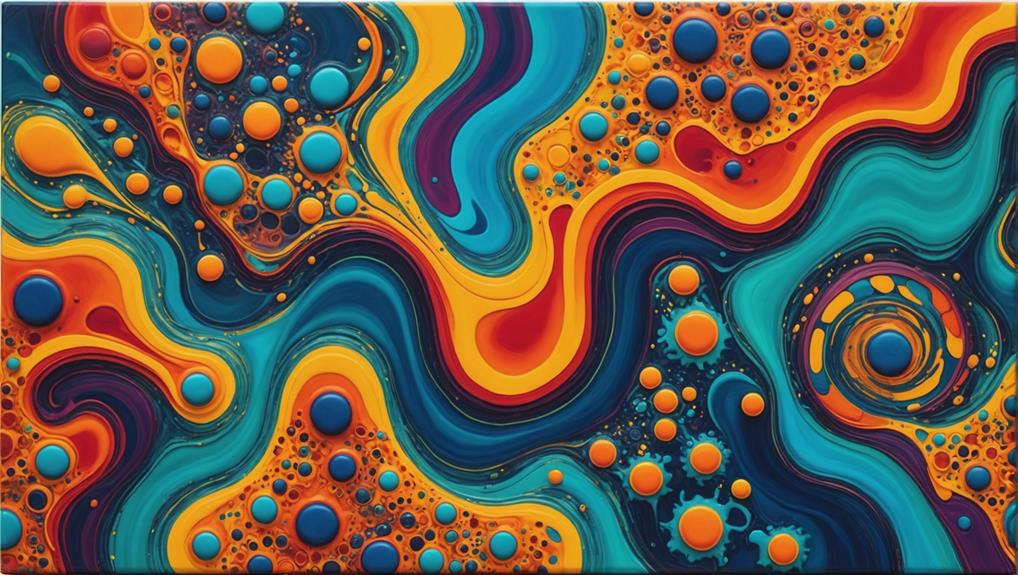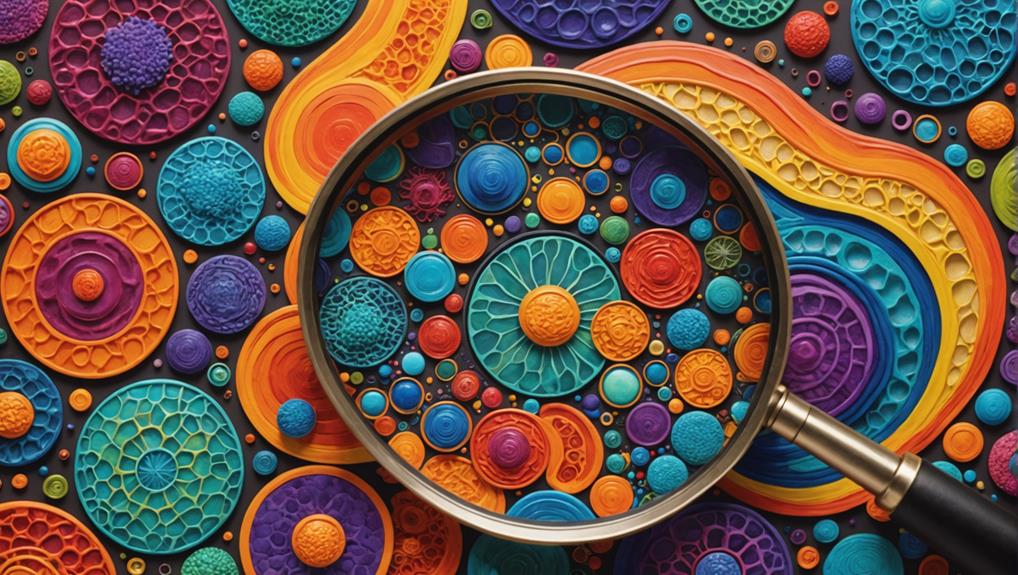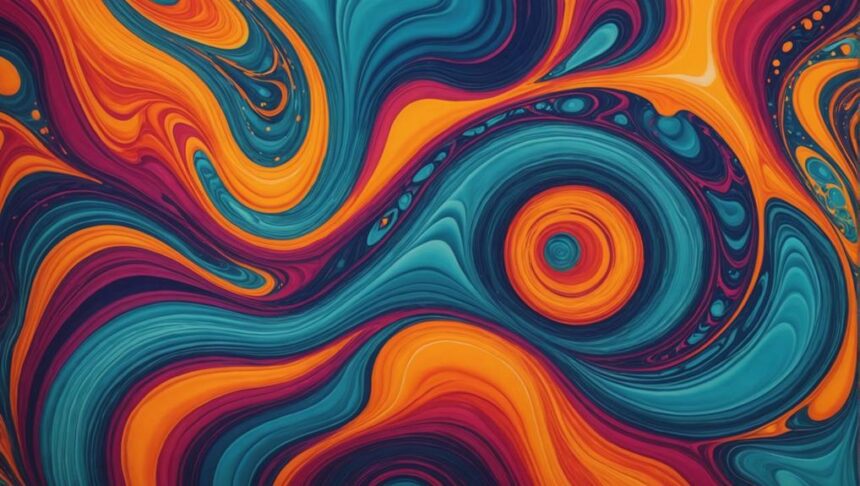Fluid art, a mesmerizing technique where paints swirl and merge to form incredible patterns, hinges on fascinating scientific principles. By understanding fluid dynamics, artists manipulate paint densities, viscosities, and layering effects to craft stunning visuals. Pigment choice matters too—lighter colors float while heavier ones sink, creating depth and surprises. Additives like Floetrol and silicone oil also play a role, improving flow and spawning unique cells. it's like a colorful chemistry experiment on canvas! If you're curious about how paint composition and techniques come together to make these awe-inspiring works, there's much more to discover in this artistic adventure.
Key Takeaways
- Fluid art utilizes principles of fluid dynamics, including viscosity and density, to create unique patterns and visual effects.
- Pigment particle size and density affect color brightness, opacity, and layering in fluid art techniques.
- Additives like Floetrol and silicone oil modify paint viscosity and surface tension, leading to enhanced cell formation and texture.
- Techniques such as dirty pour, flip cup, and swipe method produce distinct designs through controlled paint interactions.
History of Fluid Art
Fluid art, also known as paint pouring, traces its origins to the innovative techniques of Mexican artist David Alfaro Siqueiros in the 1930s. Siqueiros experimented with 'accidental painting,' where he poured acrylic paints onto wooden panels, creating spontaneous and unpredictable results. This method marked a significant leap in artistic evolution, blending art with scientific exploration.
Influential artists such as Jackson Pollock found inspiration in Siqueiros's methods, leading to further developments in fluid dynamics within their own works. Pollock and his contemporaries were fascinated by the interplay between controlled techniques and random outcomes, a concept that became central to the abstract expressionist movement. This artistic evolution was not just about the paint's movement but also about the cultural influences that shaped these artists' perspectives.
Despite its resurgence in the 2010s as a popular DIY craft trend, fluid art's foundational principles remain deeply rooted in history. The technique's appeal to both amateurs and professionals lies in its blend of artistic expression and scientific principles.
Fluid art's rich history demonstrates how cultural influences and innovative techniques can converge, resulting in a dynamic and evolving art form that continues to captivate artists and audiences alike.
Composition of Paints
The composition of paints is a significant factor in determining their performance, appearance, and suitability for fluid art techniques. Paint formulations are typically made up of three main components: pigments, binders, and solvents. Each of these plays an essential role in how the paint behaves and looks on the canvas.
Binders are fundamental in paint formulations as they help the pigments stick to the surface. Common binder types include linseed oil for oil paints and acrylic polymer emulsions for acrylic paints. These binders not only guarantee that the paint adheres well but also contribute to the durability and finish of the artwork, making your masterpiece last longer.
Solvents, like water or acrylic mediums, are used to thin the paint, making it flow more easily. This is especially important in fluid art, where the ability to spread paint smoothly across the canvas is significant.
Additives, such as Floetrol and silicone oil, can also be mixed into the paint to change its properties. For example, these additives can adjust the viscosity and help create those mesmerizing cells that are the hallmark of fluid art.
Understanding these components helps artists choose the right paint formulations for their fluid art projects, guaranteeing stunning and lasting results.
Role of Pigments
In fluid art, pigments play a vital role in creating stunning visual effects.
The size of pigment particles affects how colors mix, while their lightfastness determines how long the artwork will last without fading.
Additionally, the durability of pigments guarantees that the vibrant hues remain intact, making each piece a lasting masterpiece.
Pigment Particle Size
Pigment particle size greatly influences the opacity, brightness, and overall behavior of paint in fluid art. The size distribution of these particles can vary widely, from tiny nanometers to larger micrometers, and this range considerably impacts particle interactions in the paint.
Smaller pigment particles tend to create more vivid colors because they have a greater surface area exposed to light, making the hues appear brighter and more opaque.
In fluid art, the behavior of pigment particles is vital to achieving desired effects. Larger particles may settle more quickly in the fluid medium, which can affect the flow and final visual outcome on the canvas. This settling can lead to fascinating patterns but also requires careful control to avoid unwanted clumping.
Moreover, the dispersion of pigment particles is essential for maintaining the right viscosity of the paint. A well-dispersed paint will flow smoothly, allowing artists to create uniform patterns and intricate designs during pouring.
Understanding the relationship between particle size and distribution helps artists manipulate paint to form cells and achieve various layering techniques, adding depth and dimension to their artwork. As a result, mastering pigment particle size is key to elevating fluid art creations.
Color Mixing Dynamics
Understanding the interplay of pigments during color mixing is essential for achieving the desired visual effects in fluid art. Pigments are not just about color; they influence how paints blend and interact, creating various visual contrasts and dynamic patterns. Different pigments have distinct properties that greatly impact color perception in fluid art.
- Pigment Density: Lighter pigments, often from plants, float, while heavier metal-based pigments sink. This density difference results in fascinating layering effects in fluid art.
- Wavelength Interaction: Colors like red, with longer wavelengths, and violet, with shorter wavelengths, interact differently with light and each other, affecting the overall visual outcome of the artwork.
- Opacity and Coverage: Titanium dioxide, a common white pigment, is known for its high opacity. When mixed with other colors, it can greatly alter their appearance, adding depth and contrast.
- Strategic Color Selection: Understanding pigment properties allows artists to choose colors strategically, enhancing visual contrast and achieving specific artistic goals.
Lightfastness and Durability
While the interplay of pigments shapes the immediate visual effects in fluid art, the long-term impact on artwork vibrancy hinges on the lightfastness and durability of the pigments used.
Lightfastness refers to a pigment's ability to resist fading when exposed to light, which is essential for keeping your art looking fresh and vibrant over time. Pigments are graded by lightfastness testing, with those rated 'excellent' or 'very good' being the best choices for pieces you want to last.
Common pigments like titanium dioxide (white) and iron oxide (red, yellow, and brown) usually have good lightfastness properties, meaning they won't fade quickly.
But it's not just about the pigments; the binder you use also plays a big role. Acrylic binders, for instance, offer strong adhesion and flexibility, which help your artwork withstand the test of time.
Artists should always consider the lightfastness of all the pigments in their work. This guarantees the art remains visually impactful and resistant to fading, even when displayed in a well-lit room.
Fluid Dynamics in Art
Fluid dynamics in art plays a pivotal role in creating mesmerizing patterns on the canvas, as different paint densities interact, with lighter pigments rising and denser ones sinking.
Understanding viscosity is equally important, as it dictates how smoothly or sharply the paint flows and blends, influencing the final texture and look of the artwork.
Density Differences Impact Patterns
The interplay of varying paint densities in fluid art, governed by principles such as Rayleigh-Taylor instability, produces distinct patterns where lighter pigments ascend and denser pigments descend. This enchanting process is driven by density gradients and can be skillfully manipulated through layering techniques.
When you pour paints of different densities, lighter paints, often containing plant-based pigments, float above denser, metal-based pigments. This results in mesmerizing designs where colors seem to dance and intermingle.
Here are some key points to reflect on:
- Density Gradients: Understanding the density of your pigments is essential. Lighter colors will naturally rise, while heavier colors sink, creating dynamic, layered effects.
- Layering Techniques: Techniques like the dirty pour utilize these density differences effectively. By layering paints in a cup before pouring, you can control how they interact on the canvas.
- Rayleigh-Taylor Instability: This principle explains why lighter pigments rise and heavier pigments fall. It's the same phenomenon seen in cloud formation and ocean currents.
- Additives: Using additives like Floetrol can help fine-tune the density and viscosity of your paints, enhancing cell formation and overall visual appeal.
Viscosity Controls Paint Flow
In fluid art, understanding how viscosity influences paint flow is fundamental to mastering the creation of intricate patterns and dynamic interactions on the canvas. Viscosity refers to the thickness of a fluid, and it plays an essential role in how easily paint spreads. Lower viscosity paints, which are thinner and more fluid, can move quickly across the canvas, making it easier to achieve those stunning, intricate designs and cells.
Artists often adjust the viscosity of their paints by adding pouring mediums or additives like Floetrol. These substances enhance the fluid behavior of the paint, improving how different colors mix and interact. Knowing the viscosity of various pigments is vital; heavier, high-viscosity paints tend to sink, while lighter, low-viscosity paints rise to the surface.
Experimentation with viscosity measurement is key in fluid art. By testing and tweaking the thickness of their paints, artists can control layering effects and produce unique designs. This process of trial and error allows for a deeper understanding of fluid behavior, helping artists refine their techniques and push the boundaries of their creativity.
Ultimately, mastering viscosity is an essential step in creating mesmerizing fluid art.
Techniques of Fluid Art

Mastering various techniques in fluid art, such as dirty pour, flip cup, swipe, and ring pour, can greatly enhance an artist's ability to create diverse and compelling visual effects. Each method requires a keen understanding of color palette and layering techniques to achieve the desired outcome.
- Dirty Pour: This technique involves mixing multiple colors in a single cup before pouring them onto the canvas. The layered colors interact dynamically, creating organic patterns and cells.
- Flip Cup: In this approach, paint is layered in a cup and then flipped onto the canvas. As the cup is lifted, the colors spread and mix, influenced by their densities, resulting in intricate and unpredictable designs.
- Swipe: This method uses a tool, such as a palette knife, to drag colors across the canvas. It emphasizes the blending of different hues and can produce striking gradients and textures.
- Ring Pour: This technique requires pouring paint in concentric circles, producing a mesmerizing, ring-like effect. Artists must carefully select their color palette to guarantee harmonious shifts between layers.
Experimenting with these techniques allows artists to explore various visual outcomes, making fluid art a continually evolving and enchanting medium.
Paint Density and Viscosity
Understanding the interplay of paint density and viscosity is vital for fluid artists seeking to control the movement and interaction of colors on the canvas.
Paint density, which refers to the mass per unit volume, dictates how pigments behave when they meet. Lighter pigments, due to their lower density, tend to rise, while denser pigments sink, creating intriguing visual effects.
On the other hand, viscosity measures a fluid's resistance to flow. For fluid art, adjusting viscosity is key to determining how paint spreads and interacts. Low-viscosity paints flow easily, creating smooth blends, whereas high-viscosity paints hold their shape, allowing for distinct layers and intricate patterns.
Density variations and viscosity testing are essential for artists aiming for precision. By understanding the specific weights and viscosities of the pigments, fluid artists can predict and manipulate outcomes more effectively. This knowledge enhances the ability to create beautiful, intentional designs with intricate cells and patterns.
In fluid art, mastery over these properties doesn't just happen; it requires practice and experimentation. By continuously testing and tweaking, artists can achieve the desired aesthetic, making their work both unique and enchanting.
Additives and Their Effects

Additives play an essential role in fluid art by enhancing paint flow, facilitating cell formation, and modifying drying time.
For instance, Floetrol helps paint flow more smoothly, while silicone oil can create fascinating cells by affecting surface tension.
Additionally, certain additives can influence how quickly or slowly the paint dries, impacting the final appearance and durability of the artwork.
Enhancing Paint Flow
In fluid art, the strategic use of additives such as Floetrol, white PVC glue, and silicone oil plays an indispensable role in manipulating the viscosity, density, and flow of paint mixtures to achieve desired artistic effects. These additives are vital for additive interactions and flow optimization, allowing artists to control how their paint behaves on the canvas.
When using these additives, it's important to understand:
- Viscosity Alteration: Floetrol and white PVC glue help in thinning the paint, making it easier to spread and mix, which is especially useful for creating those beautiful, flowing designs that fluid art is known for.
- Density Manipulation: Silicone oil can introduce slight density differences in the paint, which helps in creating dynamic patterns without mixing too much.
- Flow Consistency: Proper ratios guarantee that the paint flows smoothly, preventing clumping or unwanted separation of colors during the pouring process.
- Creative Experimentation: By experimenting with different combinations and concentrations of these additives, artists can discover unique textures and patterns, showcasing the exciting interplay between art and science.
Facilitating Cell Formation
Building upon the importance of enhancing paint flow, facilitating cell formation is a key aspect of fluid art that relies on specific additives to create visually compelling patterns.
One popular additive is Floetrol, which adjusts the viscosity and density of paint mixtures. This adjustment is essential because the interaction between lighter and denser paints forms the characteristic cell structure. Denser paints sink, pushing lighter paints upward, creating those mesmerizing cell patterns.
Another important additive is silicone oil. When added to paint mixtures, silicone oil promotes cell formation by creating differences in surface tension. These differences cause the paints to separate and form distinct shapes, contributing to the unique and intricate designs seen in fluid art.
The use of these additives can greatly influence the final appearance of the artwork, as they alter the flow characteristics and interaction of paint layers during the pouring process.
Understanding how different additives affect paint behavior allows artists to manipulate their techniques for achieving the desired visual effects in their fluid art creations.
Mastering the balance of these elements enables artists to produce pieces that captivate viewers with their dynamic patterns and vibrant cell structures.
Modifying Drying Time
Artists often find that the strategic use of various additives can greatly extend the drying time of acrylic paints, providing more opportunities for blending and manipulation. Understanding the role of additives and how they interact with drying factors is essential for achieving ideal results in fluid art.
Several additives can be used to modify drying times, each having unique effects on paint formulation:
- Floetrol or GAC 800: These additives are popular for extending the drying time of acrylic paints. They allow for prolonged manipulation, enabling artists to create intricate blends and effects without the pressure of quick drying.
- Retarders: By slowing down the drying process, retarders help maintain the paint's workability. This extra time is invaluable for achieving detailed and precise effects.
- Silicone Oil: Besides promoting unique cell formations, silicone oil can also delay the drying process. This additional drying time allows for more complex designs and patterns.
- Pouring Medium: The ratio of paint to pouring medium greatly impacts drying time. Increasing the amount of medium generally results in a longer drying period, giving artists more flexibility in their creative process.
Additionally, environmental factors such as humidity and temperature play a role in the effectiveness of these additives, with higher humidity levels typically leading to slower drying times.
Creating Unique Patterns
The creation of unique patterns in fluid art hinges on the interplay of paint densities and viscosities, which drive the emergence of intricate designs.
Fluid interaction plays a pivotal role in this process, where lighter pigments rise to the surface while denser pigments sink, resulting in complex and visually enchanting designs. Artistic experimentation with different techniques, such as dirty pour, allows artists to explore the unpredictable nature of these interactions.
The Rayleigh-Taylor instability phenomenon further explains how varying densities lead to the formation of stunning visual effects, including cells and swirls. By strategically layering paints of different weights, artists can manipulate the distribution and flow of colors to achieve distinct patterns.
Viscosity is equally important; thicker paints tend to move less freely, producing more defined shapes, whereas thinner mixtures spread easily, creating broader, more fluid designs.
Experimenting with additives like silicone oil can enhance the creation of cells and intricate patterns, offering more dramatic visual effects.
This combination of density, viscosity, and additives provides artists with a broad palette of techniques to generate unique and mesmerizing fluid art pieces, each one a reflection of the fascinating interplay of scientific principles and creative expression.
Educational Benefits

Integrating fluid art into educational settings enhances learning by blending scientific principles with artistic creativity, fostering a thorough STEAM experience. This engaging approach not only stimulates artistic expression but also deepens students' understanding of scientific concepts like density and viscosity through hands-on experiments.
Participating in fluid art encourages critical thinking and problem-solving skills. As students experiment with various techniques and materials, they learn to adapt and innovate, maneuvering the unpredictable nature of fluid art. This process of exploration and discovery is invaluable in developing a resilient and inquisitive mindset.
Fluid art also promotes collaborative learning, where students work together in workshops and classes. This environment nurtures communication skills, as participants articulate their artistic processes and exchange constructive feedback. Additionally, showcasing student artwork in a gallery setting provides a platform for building presentation skills and self-confidence.
Here are some key educational benefits of integrating fluid art:
- Encourages critical thinking and problem-solving through experimentation with different techniques and materials.
- Promotes collaborative learning by fostering communication and teamwork in workshops and classes.
- Builds presentation skills and confidence through public exhibitions of student artwork.
- Provides hands-on application of scientific concepts like density and viscosity in a creative context.
Workshop and Learning Opportunities
For those seeking to investigate the world of fluid art, one-day workshops focusing on Acrylic Pouring offer a structured yet creative environment to explore various techniques. Scheduled for September, these workshops have a limited enrollment of four students each to guarantee personalized instruction and guidance. This intimate setting enhances the workshop experience, allowing participants to dive deep into the art form.
All necessary materials—paint, pouring mediums, and canvases—are included in the workshop fee, so you can focus solely on releasing your creativity. Participants are encouraged to bring their own lunch, which adds a personal touch to the breaks and fosters a relaxed, engaging atmosphere for creative collaboration.
The workshops aren't just about hands-on experience; they also promote community engagement and interaction among aspiring artists. You'll receive instructional components that include demonstrations of various pouring techniques, along with tips for achieving unique artistic effects through experimentation and understanding of paint behavior.
Frequently Asked Questions
What Is the Science Behind Fluid Art?
Fluid art combines principles of color theory and fluid dynamics. Viscosity effects, manipulated by additives, control paint movement, creating intricate designs. Rayleigh-Taylor instability explains how pigment densities interact, producing visually appealing patterns and textures.
What Is the History of Fluid Art?
Fluid art techniques originated in the 1930s with David Alfaro Siqueiros's 'accidental painting,' blending artistic expression with fluid dynamics. Historical influences include Jackson Pollock's abstract expressionism, which further popularized these spontaneous painting styles.
What Creates Cells in Paint Pouring?
Cell formation in paint pouring occurs due to differences in paint viscosity and density. Denser pigments sink while lighter pigments rise, creating a dynamic interaction that forms unique cellular patterns, enhanced by additives like Floetrol.
What Is the Purpose of the Pouring Medium for Fluid Art?
The purpose of the pouring medium for fluid art is to enhance paint flow and viscosity, enabling advanced pouring techniques. Different medium types, such as Floetrol and Liquitex, facilitate smoother application, color interaction, and extended manipulation time.
Conclusion
Fluid art, with its rich history and complex interplay of pigments, paints, and additives, offers a fascinating intersection of science and creativity.
Understanding the fluid dynamics at play and mastering various techniques can lead to the creation of unique and captivating patterns.
Beyond its aesthetic appeal, fluid art provides educational benefits and opportunities for hands-on learning through workshops.
This art form continues to evolve, captivating both artists and enthusiasts with its endless possibilities.


Leave a Reply